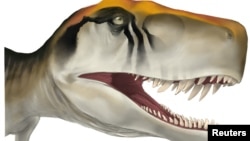Dinosaurs existed for 165 million years. The animals’ evolutionary success was partly due to their fast growth rate.
A new study finds that this pattern of fast growth appeared in the earliest dinosaurs. The researchers examined microscopic details in dinosaur bone fossils from Argentina.
The details showed that the earliest dinosaurs had growth rates similar to animals found today like mammals and birds.
Scientist Kristi Curry Rogers of Macalester College in Minnesota studies fossils. She is the lead writer of the research recently released in the publication PLOS ONE.
She said, “Growing quickly allows organisms to escape the risky business of being small for a long part of their life history.” And she added that it also allows them to reproduce more throughout their life. That means each following generation will be more successful.
The researchers examined patterns fossilized within the bones of dinosaurs and some of their relatives. The dinosaurs they looked at lived in northwestern Argentina between 231 and 229 million years ago.
Curry Rogers said cellular and chemical details in the fossils all show relative speed of growth. She added that the soft parts of the animal are no longer present, but the hard parts like the bones left a record of spaces where the soft parts once were.
She said, “This allows us to reconstruct and compare growth patterns among animals.”
The researchers studied five early dinosaurs. They all walked on two feet, were quick on their feet, had clawed hands that could hold objects and had sharp teeth.
Three were meat-eaters and the ancestors of large meat-eaters like T. rex and Giganotosaurus. The dinosaurs included Herrerasaurus and Sanjuansaurus which were around 3-4.5 meters long. The last meat-eater Eodromaeus was the size of a large bird.
The two others, Eoraptor and Chromogisaurus, were also around the size of a large bird. They were the ancestors of long-necked, four-legged large dinosaurs like Argentinosaurus and Dreadnoughtus.
All five showed signs of fast growth.
But the researchers also surprisingly found that some non-dinosaur reptiles in the same area and time had their own fast growth rates.
Quick growth was also found in four-legged Saurosuchus. It was a top-level meat-eater on land that was 7 meters long and similar to a reptile found today, the crocodile. Additionally, quick growth was found in crocodile relatives like Proterochampsa and Trialestes.
Other animals like the planting-eating reptile Hyperodapedon and mammal-like reptile Exaeretodon also grew quickly. But they regularly paused their growth throughout their life. That is different than the continuous fast growth of dinosaurs.
The first dinosaurs and these other animals evolved during a time on earth called the Triassic Period. It followed after Earth’s worst mass extinction 252 million years ago at the end of the Permian Period.
About 95 percent of different kinds of animals were lost after severe climate change. The climate change may have been caused by massive volcanic activity in an area found in today’s Russia.
Curry Rogers said that fast growth was good for them in a changing world. And she said that fast growth combined with dinosaur biology and behavior allowed dinosaurs to succeed early.
Another mass extinction at the end of the Triassic about 201 million years ago killed off many early competitors to the dinosaurs.
Curry Rogers said that as time continued, dinosaurs held onto these high growth rates. She said that lead to many different kinds of dinosaurs. But she said their competitors, like crocodile-cousins, had less differences in growth patterns and behavior.
I’m Gregory Stachel.
Will Dunham reported this story for Reuters. Gregory Stachel adapted it for VOA Learning English.
_____________________________________
Words in This Story
evolve – v. to change or develop slowly often into a better, more complex, or more advanced state
pattern – n. something that happens in a regular and repeated way
fossil – n. something (such as a leaf, skeleton, or footprint) that is from a plant or animal which lived in ancient times and that you can see in some rocks
allow – v. to permit (something)
claw – n. a sharp curved part on the toe of an animal (such as a cat or bird)
neck – n. the part of the body between the head and the shoulders
extinction – n. the state or situation that results when something (such as a plant or animal species) has died out completely









Forum